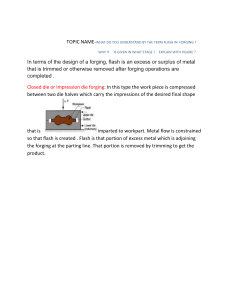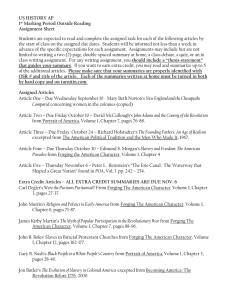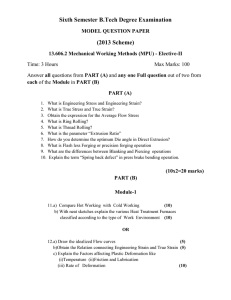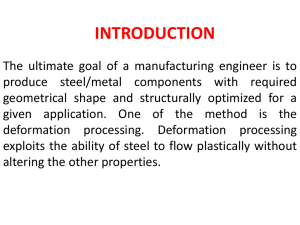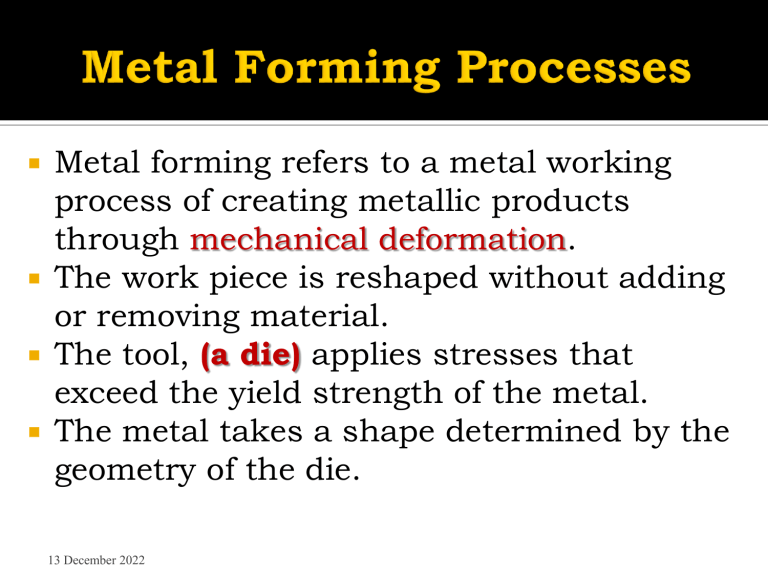
Metal forming refers to a metal working process of creating metallic products through mechanical deformation. The work piece is reshaped without adding or removing material. The tool, (a die) applies stresses that exceed the yield strength of the metal. The metal takes a shape determined by the geometry of the die. 13 December 2022 A die is a specialized tool used in manufacturing industries to cut or shape materials mostly using a pressing machine. A pressing machine is a machine tool that changes the shape of a work piece by the application of pressure. 13 December 2022 Stresses to plastically deform the metal are usually compressive stresses. Examples: rolling, forging, extrusion, …... However, some forming processes Stretch the metal (Tensile stresses) Others bend the metal (Tensile and Compressive) Still others apply shear the metal (Shearing stress) 13 December 2022 Suitable material properties: Low yield strength High ductility These properties are affected by temperature: Ductility increases and yield strength decreases when work temperature is raised Other factors: Strain rate and friction 13 December 2022 A yield strength or yield point is the material property defined as the stress at which a material begins to deform plastically. Prior to the yield point the material will deform elastically and will return to its original shape when the applied stress is removed. Elasticity is simply the ability of a material to return to its original shape and dimension when the applied load/stress is removed Ductility is when a material loaded under tensile stress deform easily and occupy the needed geometry easily. 5 1. 2. Bulk deformation Rolling processes Forging processes Extrusion processes Wire and bar drawing Bending operations Deep or cup drawing Shearing processes Sheet metal working Products of Bulk Deformation Processes Spring 2005 Deformation process in which work thickness is reduced by compressive forces exerted by two opposing rolls. 13 December 2022 The Rolls The rotating rolls perform two main functions: Pull the work into the gap between them by friction between work-part and rolls. Simultaneously squeeze the work to reduce cross section. Spring 2005 Types of Rolling By geometry of work: Flat rolling - used to reduce thickness of a rectangular cross-section. Shape rolling - a square cross-section is formed into a shape such as an I-beam. By temperature of work: Hot Rolling – most common due to the large amount of deformation required. Cold rolling – produces finished sheet and plate stock. Spring 2005 Rolled Steel Products Spring 2005 Flat Rolling It involves the rolling of slabs, strips, sheets, and plates, work-parts of rectangular cross section in which the width is greater than the thickness. Spring 2005 Flat Rolling Analysis Draft: The work is squeezed between two rolls so that its thickness is reduced by an amount called the draft. where d t o t f d = draft; to = starting thickness; and tf = final thickness Reduction: The draft is sometimes expressed as a fraction of the starting stock thickness, called the reduction Reduction = d r to When a series of rolling operations is used, reduction is taken as the sum of the drafts divided by the original thickness Spring 2005 Flat Rolling Analysis Spreading: In addition to thickness reduction, rolling usually increases work width. This is called spreading Conservation of material is preserved, so the volume of metal exiting the rolls equals the volume entering: t0 w0 L0 t f w f L f where w0 and wf are the before and after work widths (mm) L0 and Lf are the before and after work lengths (mm) Similarly, before and after volume rates of materials flow must be the same, so the before and after velocities can be related: t0 w0 v0 t f w f v f where v0 and vf are the entering and exiting velocities of the work Spring 2005 Flat Rolling Analysis Maximum Draft: There is a limit to the maximum possible draft that can be accomplished in flat rolling with a given coefficient of friction d max R 2 where; dmax = maximum draft (mm). μ = coefficient of friction R= roll radius (mm) Spring 2005 Flat Rolling Analysis Rolling Force: The rolling force can be calculated based on the average flow stress experienced by the work material in the roll gap where; Y F Y wL = average flow stress (MPa) wL = the roll-work contact area (mm2) Contact length can be approximated by L R (t0 t f ) Spring 2005 Flat Rolling Analysis The torque in rolling can be estimated by assuming that the roll force is centered on the work as it passes the rolls and that it acts with a moment arm of one-half the contact length L. T 0.5FL The power required to drive each roll is the product of torque and angular velocity where; P 2NFL P = power (J/s) F = rolling force (N) N = rotational Speed (rev/min) L = contact length (m) Spring 2005 Shape Rolling Work is deformed into a contoured cross-section rather than flat (rectangular). Accomplished by passing work through rolls that have the reverse of desired shape. Products include: Construction shapes such as I-beams, L-beams, and U-channels Rails for railroad tracks Round and square bars and rods Spring 2005 Rolling Mill Configuration Two-high – two opposing large diameter rolls Spring 2005 Rolling Mill Configuration Three-high – work passes through both directions Spring 2005 Rolling Mill Configuration Four-high – backing rolls support smaller work rolls Spring 2005 Rolling Mill Configuration Cluster mill – multiple backing rolls on smaller rolls Spring 2005 Rolling Mill Configuration Tandem rolling mill – sequence of two-high mills Spring 2005 Thread Rolling Bulk deformation process used to form threads on cylindrical parts by rolling them between two dies. Most important commercial process for mass producing bolts and screws. Performed by cold working in thread rolling machines. Advantages over thread cutting (machining): Higher production rates Better material utilization Stronger threads due to work hardening Spring 2005 Ring Rolling Deformation process in which a thick-walled ring of smaller diameter is rolled into a thin-walled ring of larger diameter. As thick-walled ring is compressed, deformed metal elongates, causing diameter of ring to be enlarged. Hot working process for large rings and cold working process for smaller rings. Applications: ball and roller bearing races, steel tires for railroad wheels, and rings for pipes, pressure vessels, and rotating. machinery Advantages: material savings, strengthening through cold working Spring 2005 Forging Forging is a deformation process in which work is compressed between two dies. Oldest of the metal forming operations, dating from about 5000 BC Components: engine crankshafts, connecting rods, gears, aircraft structural components, jet engine turbine parts. In addition, basic metals industries use forging to establish basic form of large components that are subsequently machined to final shape and size. Spring 2005 Classification of Forging Processes Cold vs. hot forging: Hot or warm forging – most common, due to the significant deformation, and the need to reduce strength and increase ductility of work metal. Cold forging - advantage is increased strength that results from strain hardening. Impact vs. press forging: Forge hammer - applies an impact load. Forge press - applies gradual pressure. Spring 2005 Classification of Forging Processes Another difference among forging operations is the degree to which the flow of the work metal is constrained by the dies. 1- Open-die forging operation. 2- Impression-die forging operation. 3- Flashless forging operation. Spring 2005 Open-die Forging Operation The work is compressed between two flat dies, thus allowing the metal to flow without constraint in a lateral direction relative to the die surfaces. Spring 2005 Impression-die Forging Operation The die surfaces contain a cavity or impression that is imparted to work-part, thus constraining metal flow - flash is created. Flash is excess metal that must be trimmed off later. Spring 2005 Flashless Forging Operation The work is completely constrained within the die and no excess flash is produced. Spring 2005 Open-die Forging Operation with No Friction If no friction occurs between work and die surfaces, then homogeneous deformation occurs, so that radial flow is uniform throughout work-part height (1) start of process with workpiece at its original length and diameter, (2) partialSpring compression, and (3) final size 2005 Open-die Forging Operation with Friction Friction between work and die surfaces constrains lateral flow of work, resulting in barreling effect (1) start of process, (2) partial deformation, and (3) final shape Spring 2005 Open-die Forging Analysis Under ideal conditions, the true strain experienced by the work during the process is determined by: ho ln h where ho= starting height; and h = height at some point during compression • At h = final value hf, true strain is maximum value Spring 2005 Open-die Forging Analysis The forging force required to continue compression at any height h during the process is obtained by F Yf A where F = Upsetting (Forging) force (N). A = Cross sectional area of the part (mm2) Yf = Flow stress corresponding to the true strain (MPa) Spring 2005 Open-die Forging Analysis In actual forging process, the force is obtained by, F K f Yf A where Kf = The Forging Shape Factor defined as: where 0.4D K f 1 h μ = Coefficient of friction. h = Work height (mm). D = Work-part diameter or other dimension representing contact length with die surface (mm) Spring 2005 Impression-die Forging Operation Compression of work-part by dies with inverse of desired part shape. Flash is formed by metal that flows beyond die cavity into small gap between die plates. Flash must be later trimmed from part, but it serves an important function during compression: As flash forms, friction resists continued metal flow into gap, constraining material to fill die cavity. In hot forging, metal flow is further restricted by cooling against die plates. Spring 2005 Impression-die Forging Operation o Several forming steps often required, with separate die cavities for each step. o Beginning steps redistribute metal for more uniform deformation. o Final steps bring the part to its final geometry. Sequence in impression-die forging: (1) just prior to initial contact with raw work-piece, (2) partial compression, and (3) final die closure, causing flash to form in gap between die plates. Spring 2005 Impression-die Forging Operation Advantages and Limitations Advantages compared to machining from solid stock: Higher production rates. Conservation of metal (less waste). Greater strength. Limitations: Not capable of close tolerances Machining often required to achieve accuracies and features needed, such as holes, threads, and mating surfaces that fit with other components Spring 2005 Flashless Forging Operation Compression of work in punch and die tooling whose cavity does allow for flash. Starting work-part volume must equal die cavity volume within very close tolerance. Best suited to part geometries that are simple and symmetrical Often classified as a precision forging process (1) just before initial contact with work-piece, (2) partial compression, and (3) final punch and die closure Spring 2005 Forging Hammers (Drop Hammers) Apply an impact load against work-part - two types: Gravity drop hammers impact energy from falling weight of a heavy ram Power drop hammers accelerate the ram by pressurized air or steam Disadvantage: impact energy transmitted through anvil into floor of building Most commonly used for impression-die forgingSpring 2005 Forging Presses Apply gradual pressure to accomplish compression operation types: Mechanical presses - converts rotation of drive motor into linear motion of ram Hydraulic presses - hydraulic piston actuates ram Screw presses - screw mechanism drives ram Spring 2005 Upsetting and Heading Forging process used to form heads on nails, bolts, and similar hardware products. More parts produced by upsetting than any other forging operation. Performed cold, warm, or hot on machines called headers or formers. Wire or bar stock is fed into machine, end is headed, then piece is cut to length. For bolts and screws, thread rolling is then used to form threads. Spring 2005 Upsetting and Heading An upset forging operation to form a head on a bolt or similar hardware item The cycle consists of: (1) wire stock is fed to the stop (2) gripping dies close on the stock and the stop is retracted (3) punch moves forward (4) bottoms to form the head Spring 2005 Upsetting and Heading Examples of heading (upset forging) operations: (a) heading a nail using open dies (b) round head formed by punch (c) and (d) two common head styles for screws formed by die (e) carriage bolt head formed by punch and die Forming and related operations performed on metal sheets, strips, and coils. High surface area-to-volume ratio of starting metal, which distinguishes these from bulk deformation. Often called press-working because presses perform these operations. Parts are called stampings. Usual tooling: punch and die. Sheet Metal Bending Basic sheet metalworking operations: bending Deep Drawing Basic sheet metalworking operations: drawing Shearing of Sheet Metal Basic sheet metalworking operations: shearing Plastic region of stress-strain curve is primary interest because material is plastically deformed In plastic region, metal's behavior is expressed by the flow curve: Y f K n where K = strength coefficient; and n = strain hardening exponent Flow curve based on true stress and true strain For most metals at room temperature, strength increases when deformed due to strain hardening Flow stress = instantaneous value of stress required to continue deforming the material Y f K n where Yf = flow stress, i.e., the yield strength as a function of strain Determined by integrating the flow curve equation between zero and the final strain value defining the range of interest _ Yf K n 1 n where Y = average flow stress; and = maximum strain during deformation process. n = strain hardening exponent _ f For any metal, K and n in the flow curve depend on temperature. Both strength (K), and strain hardening (n) are reduced at higher temperatures. In addition, ductility is increased at higher temperatures. o Any deformation operation can be: accomplished with lower forces, and power at elevated temperature. Three temperature ranges in metal forming: Cold working Warm working Hot working Performed at room temperature or slightly above. Many cold forming processes are important mass production operations. Minimum or no machining usually required. Better accuracy, closer tolerances Better surface finish Strain hardening increases strength and hardness No heating of work required Higher forces and power required in the deformation operation Ductility and strain hardening limit the amount of forming that can be done In some cases, metal must be annealed to allow further deformation In other cases, metal is simply not ductile enough to be cold worked. As Cold work is increased • Yield strength (sy) increases. • Tensile strength (TS) increases. • Ductility (%EL or %AR) decreases. low carbon steel • What are the values of yield strength, tensile strength & ductility after cold working Cu? Copper Cold Work Do = 15.2 mm %CW = Dd = 12.2 mm pDo2 pDd2 4 x 100 %CW = 4 pDo2 4 Do2 - Dd2 = x 100 Do2 (15.2 mm) 2 - (12.2 mm) 2 (15.2 mm) 2 x 100 = 35.6% 500 300 300 MPa 100 0 20 40 Cu % Cold Work 60 sy = 300 MPa 60 800 600 400 340 MPa Cu 200 0 20 40 60 % Cold Work TS = 340 MPa ductility (%EL) 700 tensile strength (MPa) yield strength (MPa) • What are the values of yield strength, tensile strength & ductility for Cu for %CW = 35.6%? 40 20 Cu 7% 00 20 40 60 % Cold Work %EL = 7% • 1 hour treatment at Tanneal... decreases TS and increases %EL. • Effects of cold work are nullified! 100 200 300 400 500 600 700 600 60 tensile strength 50 500 40 400 30 ductility 300 20 ductility (%EL) tensile strength (MPa) annealing temperature (ºC) • Three Annealing stages: 1. Recovery 2. Recrystallization 3. Grain Growth During recovery, some of the stored strain energy is relieved. In addition, properties such as electrical and conductivities are recovered to their worked states. internal physical thermal precold- New grains are formed that: -- have low dislocation densities -- are small in size -- consume and replace parent cold-worked grains. 0.6 mm 33% cold worked brass 0.6 mm New crystals nucleate after 3 sec. at 580C. • All cold-worked grains are eventually consumed/replaced. 0.6 mm After 4 seconds 0.6 mm After 8 seconds All cold-worked grains are eventually consumed/replaced. 0.6 mm After 4 seconds 0.6 mm After 8 seconds Can be induced by rolling a polycrystalline metal - before rolling - after rolling rolling direction 235 m - isotropic since grains are equiaxed & randomly oriented. - anisotropic since rolling affects grain orientation and shape. • At longer times, average grain size increases. -- Small grains shrink (and ultimately disappear) -- Large grains continue to grow 0.6 mm After 8 s, 580ºC 0.6 mm After 15 min, 580ºC • Empirical Relation: exponent typ. ~ 2 grain diam. n d at time t. - don = Kt coefficient dependent on material and T. elapsed time TR = recrystallization temperature TR º TR = recrystallization temperature = temperature at which recrystallization just reaches completion in 1 h. 0.3Tm < TR < 0.6Tm For a specific metal/alloy, TR depends on: • %CW -- TR decreases with increasing %CW • Purity of metal -- TR decreases with increasing purity. Performed at temperatures above room temperature but below recrystallization temperature Dividing line between cold working and warm working often expressed in terms of melting point: 0.3Tm, where Tm = melting point (absolute temperature) for metal. Lower forces and power than in cold working More intricate work geometries possible Need for annealing may be reduced or eliminated Low spring back Disadvantage: 1. Scaling of part surface Deformation at temperatures above the recrystallization temperature Recrystallization temperature = about one-half of melting point on absolute scale In practice, hot working usually performed somewhat above 0.6Tm Metal continues to soften as temperature increases above 0.6Tm, enhancing advantage of hot working above this level Capability for substantial plastic deformation of the metal - far more than possible with cold working or warm working. Why? Strength coefficient (K) is substantially less than at room temperature. Strain hardening exponent (n) is zero (theoretically) Ductility is significantly increased. Work-part shape can be significantly altered Lower forces and power required Metals that usually fracture in cold working can be hot formed Strength properties of product are generally isotropic No work hardening occurs during forming. Lower dimensional accuracy in case of bulk forming Higher total energy required (due to the thermal energy to heat the work-piece) Work surface oxidation (scale), poorer surface finish Shorter tool life
